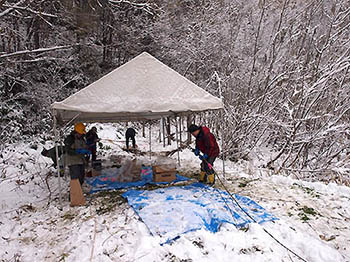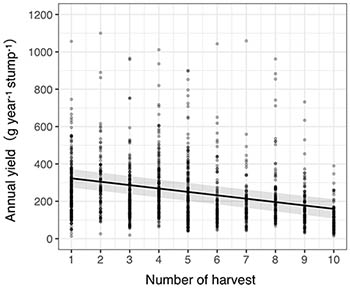Home > Research > Research Results > Research Results 2020 > A 10-year harvest experiment reveals factors that affect the biomass yield of willow
Update:December 7, 2020
Main content starts here.
A 10-year harvest experiment reveals factors that affect the biomass yield of willow
| Article title |
The effects of weather, harvest frequency, and rotation number on yield of short rotation coppice willow over 10 years in northern Japan |
|---|---|
| Author (affiliation) |
Hisanori Harayama (a), Akira Uemura (a), Hajime Utsugi (b), Qingmin Han (a), Mitsutoshi Kitao (c), Yutaka Maruyama (d) (a) Department of Plant Ecology, FFPRI, Tsukuba, Ibaraki, Japan. (b) Principal Research Director, FFPRI, Tsukuba, Ibaraki, Japan. (c) Hokkaido Research Center, FFPRI, Sapporo, Hokkaido, Japan. (d) Nihon University, Fujisawa, Kanagawa, Japan. |
| Publication Journal |
Biomass and Bioenergy, 142: 105797, Elsevier, November 2020 DOI:10.1016/j.biombioe.2020.105797( External link ) |
| Content introduction |
The use of energy from wood biomass is attracting attention as one way of counteracting global warming resulting from greenhouse gases. We are conducting researches with the aim of introducing a method for cultivating willow to produce biomass, called short rotation coppice willow, in Japan, as is being done in Europe and North America. In this method, the above-ground area is cut and harvested in an extremely short period of 2 to 5 years in order to regenerate trees by sprouting instead of planting. Harvesting is typically repeated 6 to 8 times over a 20- to 25-year period. However, in most of the willow cultivation experiments conducted in the world so far, data were analyzed when repeated harvests were made up to 4 times. Therefore, the effect on yield of increasing the number of harvests has not been fully understood. In the present study, we harvested either annually or biennially for 10 years (Photo) in a well-fertilized willow plantation, and we analyzed the relationship between the number of harvests and yield by a statistical model taking such factors as the effects of harvest intervals and climatic conditions into account. The model predicted that number of harvests had a significant negative effect of annual yield, and the yield could be halved over 10 consecutive years of harvesting (Figure), whereas harvesting every other year helped to suppress decreases in annual yield. Furthermore, we also revealed from the model analysis that annual yield could be decreased when sunlight hours were short during the growth period, when temperatures during the May leafing period were low, when there was little rainfall during the period of robust growth in July. This is the first paper in the world that has quantitatively revealed the effects that the number of harvests and climatic conditions have on biomass yield from willow, and the results will help to improve production of woody biomass in short rotation coppice willow.
Photo: Scene of the harvest experiment. The diameter, height, weight, etc., of harvested willow were measured. The experimental plantation was established with assistance of staff of the Shimokawa town office in Hokkaido, who also assisted every year during the 10-year survey.
Figure: The relationship between number of harvests and annual willow biomass yield over a 10-year period. The lines and shaded area in the graph represent trends estimated by the statistical model, and the 95% confidence interval, respectively. |
Copyright © Forest Research and Management Organization. All rights reserved.


